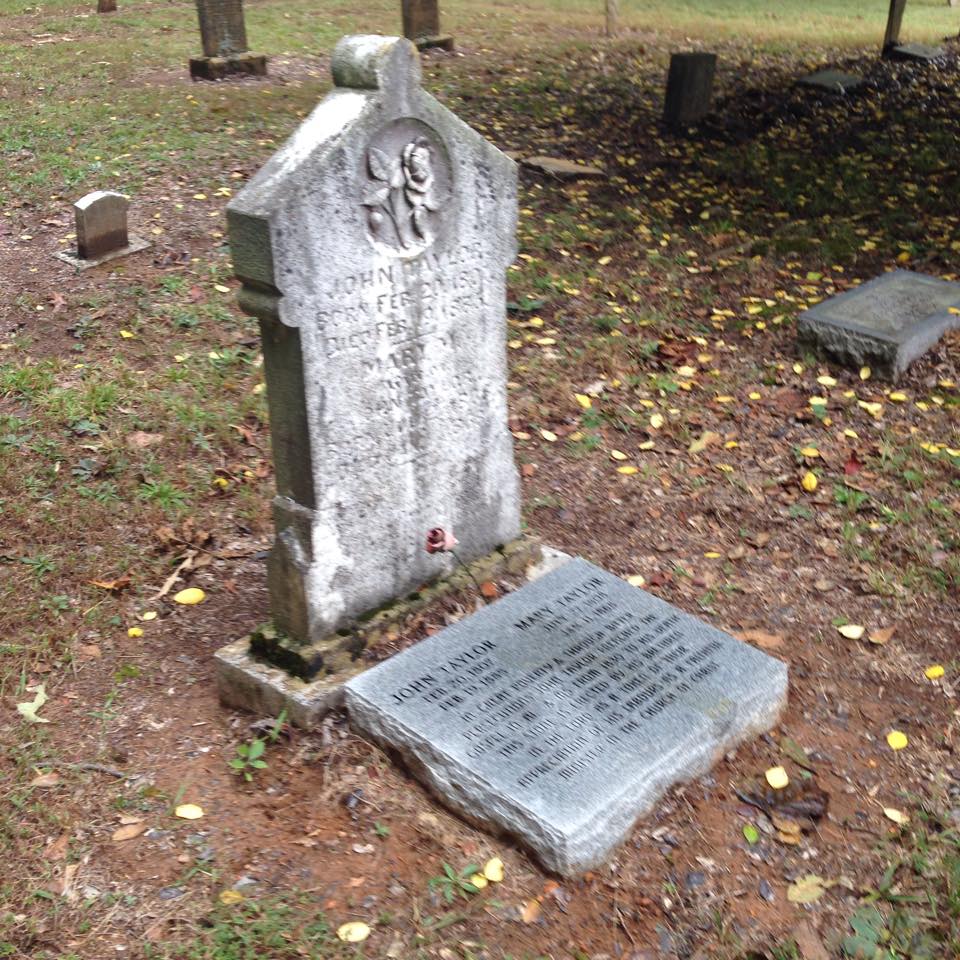John Taylor
1807-1885
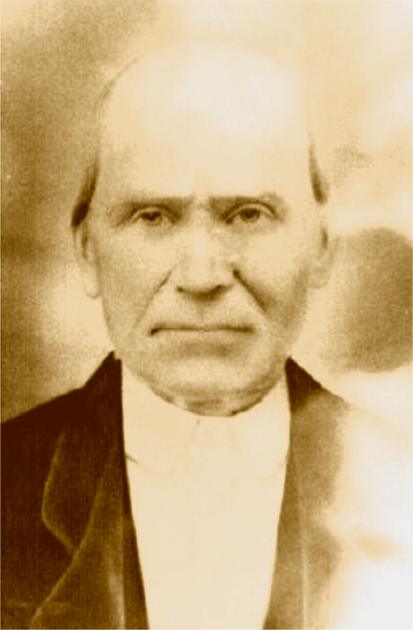
Biographical Sketch On The Life Of John Taylor
We should not forget that we are building on the labors and sacrifices of others. Some of those who have sacrificed and suffered most have been forgotten. Let us give honor to whom honor is due and tribute to whom tribute is due. The hero of this sketch has been forgotten, but his labors and works still follow him.
John Taylor was born on February 20, 1807, in South Carolina. His people were members of the Baptist Church, and young Taylor was trained in the Baptist faith. He moved to North Alabama in 1827, when he was twenty years of age. He had no education, save that which he had gathered from observation, conversation, and social intercourse with neighbors. He was blessed with a strong intellect and a determined will. His people were honest, and John Taylor was impressed early in life with the value of honesty and truthfulness. Not only was he honest with material things and in dealing with his fellow men, but he was honest with the truth of God. He read the Bible and interpreted it in the light of Baptist traditions. He began to preach soon after he joined the Baptist Church. When he came into the Baptist Church, he had some doubt as to some of the teachings of that church. He was considered "queer," but he had his own way of reaching his conclusions. He did not believe that God had pardoned his sins before he was baptized. He read the New Testament, and read that the Holy Spirit, through Peter, said to the people on the day of Pentecost, "Repent ye, and be baptized every one of you in the name of Jesus Christ unto the remission of your sins," and he could not understand why he should be baptized because his sins were already forgiven.
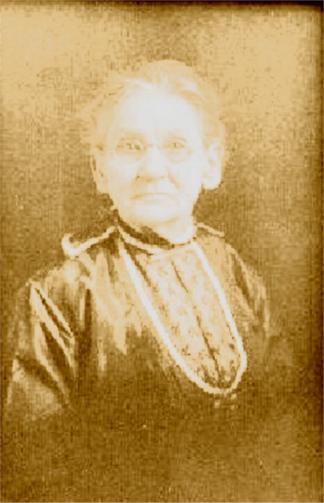
Thought By Some To Be
Mary Taylor, Wife Of John Taylor
When John Taylor was interested in his salvation, during a Baptist meeting in his community, the preacher quoted Peter's reply to the question, "What must I do to be saved?" And he heard this reply and meditated briefly upon it. He thought that if people who had helped to crucify the Savior could be saved by doing what Peter told them to do, he could be saved in the same way. So immediately he began to rejoice and to clap his hands. The preacher announced at once: "John Taylor has got religion." John Taylor replied: "No, brother, I haven't got religion, but I see how I can get it." He demanded baptism of the preacher at once, but the preacher could not follow Baptist usage and baptize him. The preacher wanted him to tell his experience, but he had no experience to tell. So the Baptist preacher refused to baptize him. There was another Baptist preacher in the community, and John Taylor went to him and asked that he baptize him. This Baptist preacher replied that he had no authority to baptize him without the consent of the church. This preacher finally agreed that he would baptize him on a confession of his faith, provided that young Taylor would not say anything about it. They set the hour at midnight and the preacher and Taylor were to meet at that hour and the preacher would baptize him. John Taylor and his wife went at the appointed time and remained there on the bank of the creek till early next morning, but the preacher did not come. When John Taylor saw the preacher and asked for an explanation as to why he did not come and baptize him, the Baptist preacher replied that it did not look right to be doing anything under the cover of night that way. He promised John Taylor that if he would come to the church next Sunday he would try to get the church to let him baptize him. John Taylor was present and the Baptist preacher did his best to get the church to let him baptize him, but the Baptist Church refused to give him permission to do so. The Baptist preacher was interested in John Taylor and finally baptized him without the consent of the Baptist Church.
John Taylor did not preach long for the Baptists before he caused them trouble He did not try to follow "Baptist usage," but he sincerely tried to follow the New Testament. Of course this would get him in trouble with the Baptist Church. He was very familiar with the New Testament and could give authority for all that he preached. It was not long before the Baptist Church began to make charges against him that he was preaching heresy. He proposed to give them book, chapter, and verse for all that he taught but this did not satisfy them. The Baptist Church considered anything heresy among them that did not conform to "Baptist usage." The standard of loyalty and faithfulness to the Lord Jesus Christ was determined, not by the New Testament, but by "Baptist usage." When measured by this standard, John Taylor was a heretic. In fact he was a heretic before they took him into the Baptist Church; but after he became an active worker and public proclaimer of the teachings of the New Testament, he was a greater heretic. When he was excluded from the Baptist Church he did not know what to do. He did not know whether he could continue to preach or not. He advised with his brother, who was not a religious man, and his brother told him that he was as much suited and fit to preach after the Baptists had excluded him as he was before. So he decided to continue to preach what he found revealed in the New Testament.
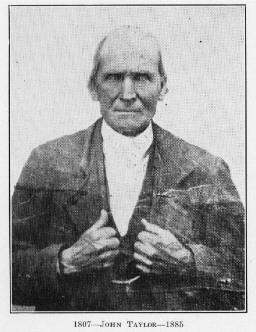
Soon Brother Taylor saw that he could preach all that he found in the New Testament and could baptize believing penitents upon a simple confession of their faith in the Lord Jesus Christ without the sanction of the Baptist Church or any other human organization. He rejoiced in his newly found freedom and proclaimed boldly the gospel as God's power to save to the simple folk of Northern Alabama. He found many who were anxious to hear the simple truth and obey it. The people of that section were good hard-working, honest people. They knew but little about the gospel or the church revealed in the New Testament, knowing only such things as illiterate preachers had preached concerning the different religious faiths of the denominations in that country. When Brother Taylor went to them with the simple story of Jesus and taught them that they could become children of God by obedience to the gospel without going through some emotional state which they called "getting religion," the people were glad to accept the truth. Of course Brother Taylor had many religious enemies. Many of them said that he preached only "a pack of lies" and many others attempted to keep the people from breaking away from the religious bondage into which denominationalism had brought them. Many congregations of disciples of Christ were formed by Brother Taylor, and many of the larger churches in North Alabama today are the result of his preaching. Brother Taylor had never heard of Alexander Campbell when he began preaching the gospel. He did not learn what he preached from Mr. Campbell or from any other man, but he learned it from the New Testament
Brother Taylor preached as he had opportunity and received but little for his preaching. He lived a simple humble life, and preached the gospel to the same class of people. He spent his last days with his daughter, who lived in a log cabin in the mountains of North Alabama. When he was not able to meet with the church and eat the Lord's Supper, he would worship the Lord in his home. People who knew him had confidence in him. Even those who did not believe the gospel as he preached it respected him for his strong conviction and deep piety. He died on February 19, 1885, and was buried in the little cemetery near Rock Creek Church. [Note: Not at Rock Creek Cemetery. See below.] Some years after his death churches throughout that country made contributions, and there now stands a modest monument that marks the resting-place of one of the most humble and faithful and consecrated servants of the Lord, John Taylor. [Note: C. Wayne Kilpatrick at International Bible College in Florence, Alabama stated that he learned from Earl West that F.D. Srygley purchased the stone from the proceeds of the sales of the book, "Larimore And His Boys" around 1889, 90. Most of what is known about Taylor is found in that book.
-From Biographical Sketches Of Gospel Preachers, ed. H. Leo Boles, Gospel Advocate Co. Nashville, Tennessee, c.1932, p.130-134
![]()
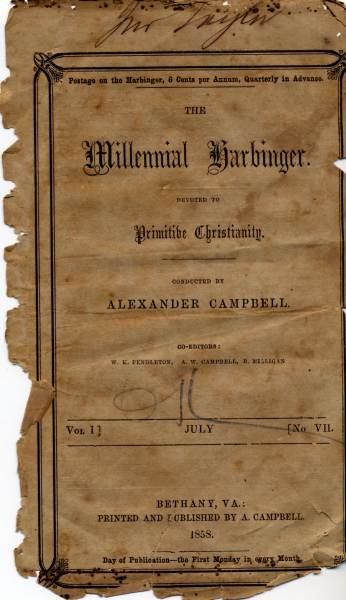
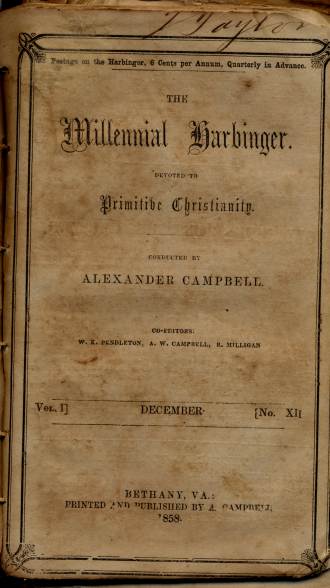
Two Of John Taylor's Personal Copies Of The Millennial Harbinger
Note John Taylor's Signatures At The Top
Thanks To Wayne Kilpatrick For These Contributions
![]()
Directions To The Grave Of John Taylor
GPS: 34.559417, -87.865279
Efforts have been made to preserve the whereabouts of the final resting place of John Taylor. In the above biographical sketch by Boles, he explains that Taylor is buried at Rock Creek. He is not there, but did preach and work there. He is buried in the Taylor family cemetery just up from Shady Grove Church of Christ further over toward Frankfurt from Rock Creek, about 5 miles away.
My family and I had an opportunity to go by and see the Taylor cemetery while in that area in October, 97. I'll give you the directions below, but first a word to the wise. Don't lock your keys in your car while in the cemetery like we did. It was an afternoon to remember. Three hours later a locksmith came the 25 miles from Muscle Shoals and let us go for about $40.00. But, that's another story.Directions From Muscle Shoals: At Hwy 43 & 72 go west on 72 toward Iuka, MS. Go 8.4 miles and turn left on Hwy. 242 toward Red Bay. (A yellow caution light there). Go toward Red Bay 11.1 miles until you reach the Srygley Church of Christ on the right. There in front of the church building turn left on County Rd. 58. Go .4 mile to stop sign. Turn right on Henry Rd. (road forks, bear to right). [Note: If you want to see the old Rock Creek Church where Larimore, Taylor, the Srygleys and others preached, you can bear left at the fork and the building is about 200 yards up on the right]. Carry on after bearing the right 1.8 miles to the stop sign. Turn left and go 3.5 miles to just past Shady Grove Church of Christ on the right. At the top of the hill turn right onto a gravel road. Go about 200 yards further up to the old Taylor Cemetery. It is very nicely kept cemetery. Looking at the cemetery, look to the right side about two or three rows back. The grave has one main marker and two foot markers.
Directions From Russellville: At Hwy 43 & 24 go west on Hwy 24 6.1 miles and turn right on Franklin County Rd. 36 (a sign is also there for the county landfill. Go out 36 to the stop sign and turn left. Go .7 miles to the Cedar Creek Cumberland Presbyterian Church on the (left) and turn right on County Rd. 41 there in front of the church building. Go about 5 miles to the stop sign and turn left. Go about 1.1 miles and turn left onto the grave road that leads up to the cemetery. If you get to Shady Grove Church of Christ you've gone too far. Turn around and come back to the top of the hill and turn right. Go about 200 yards up to the old cemetery. Looking at the cemetery, look to the right side about two or three rows back. The grave has one main marker and two foot markers.
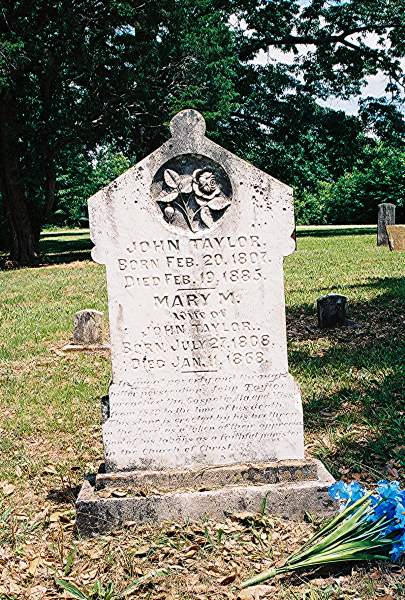
John Taylor
Born: Feb. 20, 1807
Died Feb. 19, 1885
Mary M.
wife of
John Taylor
Born Jul. 27, 1808
Died Jan. 11, 1868
In great poverty and through
bitter persecution John Taylor
Preached the Gospel in Ala. and Miss.
from 1830 to the time of his death.
This stone is erected by his brethren
in the Lord as a token of their apprecia-
tion of his labors as a faithful minister
in the Church of Christ
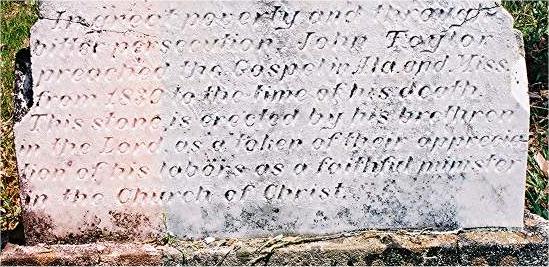
New Photo
![]()
